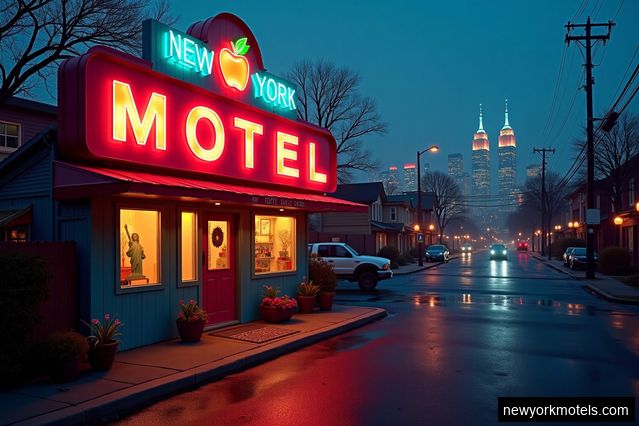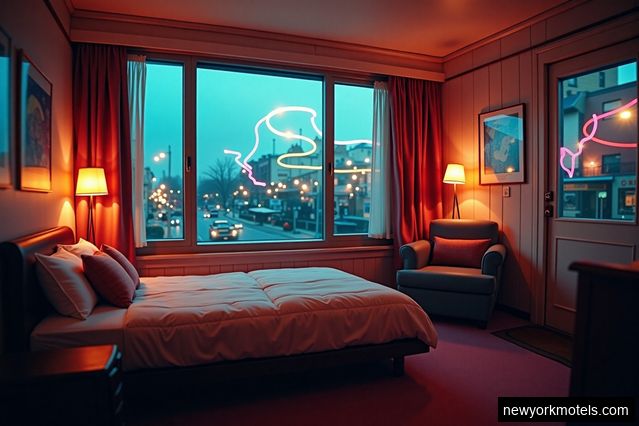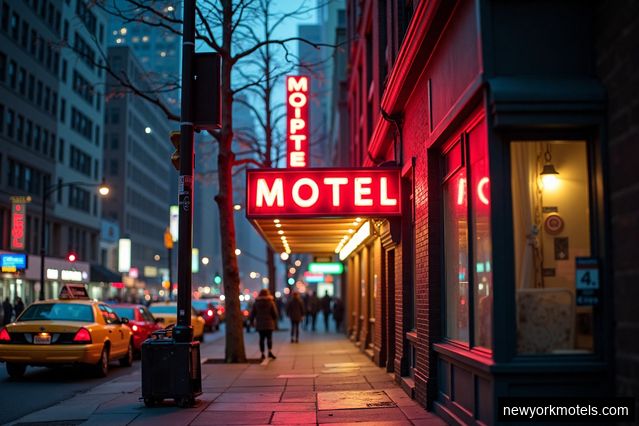Introduction
New York City, the iconic metropolis with its towering skyscrapers and bustling streets, possesses a unique allure, attracting millions of travelers each year. However, for many of these visitors, especially those with mobility challenges, navigating the city and finding accessible accommodation can be challenging. This blog post aims to guide travelers through the labyrinth of New York motels, with a focus on accessibility for those with disabilities.
In this article, we will explore the current state of motel accessibility in New York, delve into the legal requirements for accessible accommodations, highlight some of the best motels that prioritize accessibility, and discuss the potential pitfalls and challenges faced by travelers. Each section will provide practical advice, enriched by real-life examples and expert perspectives, to help you make informed decisions when planning your next trip to the Big Apple.
In delving deeper into the intricacies of this vibrant city, the introduction merely scratches the surface of what New York City truly embodies. Beyond its iconic skyline, the city pulsates with a rich tapestry of cultures, each neighborhood telling a unique story of its own. From the artistic enclave of Chelsea to the historic charm of Greenwich Village, every corner of the city offers a different perspective, waiting to be explored.
Moreover, the introduction sets the stage for a journey into the dynamic blend of old and new that defines New York City. While the towering skyscrapers symbolize progress and modernity, the cobblestone streets of So Ho whisper tales of the city's past, creating a captivating contrast that encapsulates the essence of this metropolis. As we unravel the layers of this urban playground, we begin to appreciate the depth of history, art, and innovation that converge in this bustling city that never sleeps.
State of Motel Accessibility in New York
The state of motel accessibility in New York is a mixed bag. While strides have been made in recent years to improve accessibility, there is still much work to be done. For instance, the Holiday Inn Express in Manhattan provides a shining example of accessible accommodation, with features such as wheelchair-accessible rooms, lowered counters, and accessible parking. However, other motels, like the Motel 6 in Queens, have been criticized for their lack of accessible features.
Statistics from the American Hotel & Lodging Association indicate that only about 60% of motels in New York City are fully accessible. This means that 40% of motels may pose challenges to travelers with disabilities. Given the city's position as a top tourism destination, this is a significant issue that needs to be addressed.
While New York has made progress in enhancing motel accessibility, challenges persist in certain areas. For instance, some older motels in upstate New York may still lack adequate wheelchair ramps or accessible parking spaces, hindering the ease of accommodation for travelers with disabilities. On the other hand, major cities like New York City have been more proactive in enforcing accessibility regulations, with many chain motels ensuring compliance with the Americans with Disabilities Act (ADA) standards.
Moreover, the state government has been investing in programs to incentivize motel owners to upgrade their facilities to meet accessibility requirements. This includes providing tax credits for renovations that focus on improving accessibility features such as wider doorways, grab bars in bathrooms, and accessible room layouts. Despite the ongoing challenges, there is a noticeable shift towards greater accessibility awareness and improvements in New York's motel sector, aiming to create a more inclusive and welcoming environment for all guests.
Legal Requirements for Accessible Motels
Under the Americans with Disabilities Act (ADA), motels are legally required to provide certain accessible features. These include wheelchair-accessible routes, visual and auditory aids for the hearing and visually impaired, and rooms with sufficient space for wheelchair maneuverability. Furthermore, motels must provide details about these accessible features on their websites to aid travelers in their decision-making process.
Despite these legal requirements, many motels in New York still fall short. A 2018 study by the New York Lawyers for the Public Interest found that many motels failed to provide accurate or complete information about their accessibility features online. As a result, travelers with disabilities often find themselves in difficult situations upon arrival.
In addition to physical accessibility standards, motels must also comply with regulations regarding communication access for guests with hearing or visual impairments. This includes providing accessible communication devices like TTY machines and ensuring that emergency information is available in formats such as braille or large print. These measures are crucial for ensuring that all guests, regardless of their abilities, can effectively communicate and access necessary information during their stay. Furthermore, motels are required to have designated accessible parking spaces with proper signage and pathways that lead to accessible entrances. These features not only promote inclusivity but also demonstrate a commitment to accommodating the diverse needs of all guests, making their experience comfortable and convenient.
Best Accessible Motels in New York
Despite these challenges, there are a number of motels in New York that excel in providing accessible accommodations. The Hampton Inn Manhattan-Times Square North, for example, has been lauded for its extensive accessible features, including roll-in showers, visual alarms, and lowered peepholes. Likewise, the Comfort Inn Times Square South Area has received rave reviews for its accessible rooms, helpful staff, and convenient location.
The Holiday Inn Manhattan - Financial District also deserves special mention. Beyond its ADA-compliant rooms, it provides assistive listening devices and has staff trained in sign language, demonstrating an exceptional commitment to accessibility. Travelers with disabilities often praise these motels for their efforts to accommodate their needs and make their stay as comfortable as possible.
While the quest for accessible accommodations can often be daunting, New York City surprisingly offers a range of motels that set the bar high in terms of accessibility and inclusivity. For instance, the Park Central Hotel stands out for its commitment to providing barrier-free access throughout the property, ensuring that all guests can move around with ease. Additionally, the Hotel Pennsylvania goes above and beyond by offering spacious rooms equipped with grab bars and roll-in showers, catering to guests with mobility challenges.
Moreover, the The Westin New York at Times Square is another gem in the city, featuring ADA-compliant rooms that are thoughtfully designed for comfort and convenience. With a dedicated staff trained in accessibility requirements, these motels not only prioritize physical accommodations but also ensure a welcoming and inclusive environment for all visitors seeking a memorable stay in the bustling city of New York.
Pitfalls and Challenges
Despite the best efforts of many motels, travelers with disabilities still face numerous challenges when visiting New York. In addition to the lack of accessible accommodations, they often encounter obstacles such as inaccessible public transportation and sidewalks, as well as a lack of understanding and awareness about their needs.
Furthermore, the cost of accessible accommodations can be prohibitive. A study by the New York State Comptroller found that accessible rooms in New York City were, on average, 12% more expensive than standard rooms. This additional cost can be a significant barrier for travelers with disabilities, further limiting their choices.
In addition to physical accessibility challenges, another common pitfall faced by travelers with disabilities is the lack of adequate communication support. Imagine arriving at a hotel only to realize that the staff is not trained in sign language or the reservation system does not accommodate special requests for communication devices. Such barriers can severely hinder the overall travel experience and leave individuals feeling isolated and frustrated. These communication challenges highlight the importance of not only physical accessibility but also the need for inclusive practices that cater to diverse communication needs.
Moreover, a significant challenge that often goes unnoticed is the lack of awareness among hospitality staff regarding the specific needs of guests with disabilities. For instance, some employees may not be familiar with how to assist a visually impaired guest or may unintentionally overlook necessary accommodations. This lack of awareness can lead to misunderstandings, discomfort, and even safety risks for travelers with disabilities. Addressing this challenge requires comprehensive training programs that educate staff on disability etiquette, assistive technologies, and proactive approaches to ensure a welcoming and inclusive environment for all guests.
Conclusion
Navigating New York as a traveler with disabilities can be a challenging endeavor. The lack of fully accessible motels, coupled with the high cost of accessible rooms, often makes planning a trip to the city a daunting task. However, with careful planning and research, it is possible to find motels that not only meet the legal requirements for accessibility but go above and beyond to ensure their guests' comfort and satisfaction.
In conclusion, when planning your next trip to New York, it's essential to research and choose motels with a strong commitment to accessibility. Look for motels that provide detailed information about their accessible features online and have positive reviews from travelers with disabilities. And remember, while the journey may be challenging, the rewards of experiencing the vibrant culture and energy of New York City are well worth the effort.
In conclusion, while navigating New York as a traveler with disabilities poses its challenges, it is essential to highlight the strides being made towards greater accessibility in the city. Initiatives such as the installation of more accessible subway stations, the implementation of audio-tactile pedestrian signals, and the availability of wheelchair-accessible taxis are significant steps in improving the overall experience for individuals with disabilities.
Moreover, the collaboration between local authorities and advocacy groups has led to the development of comprehensive accessibility guides for tourists with disabilities, offering detailed information on accessible attractions, dining options, and accommodations. By continuing to prioritize inclusivity and accessibility, New York not only enhances the travel experience for individuals with disabilities but also sets an example for other cities striving to create more inclusive environments.









